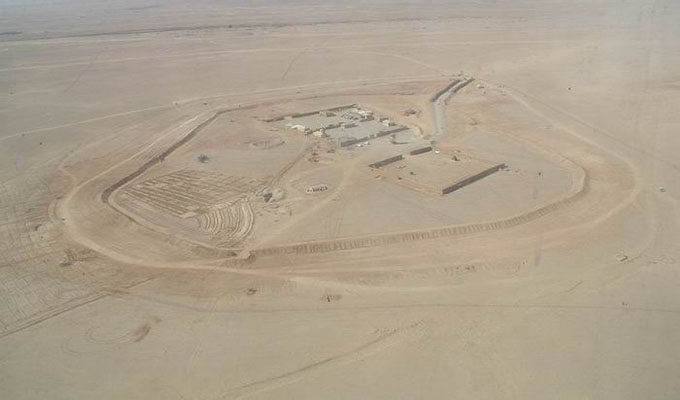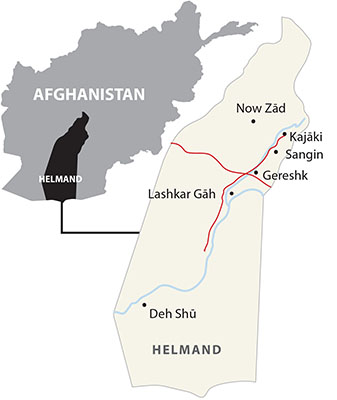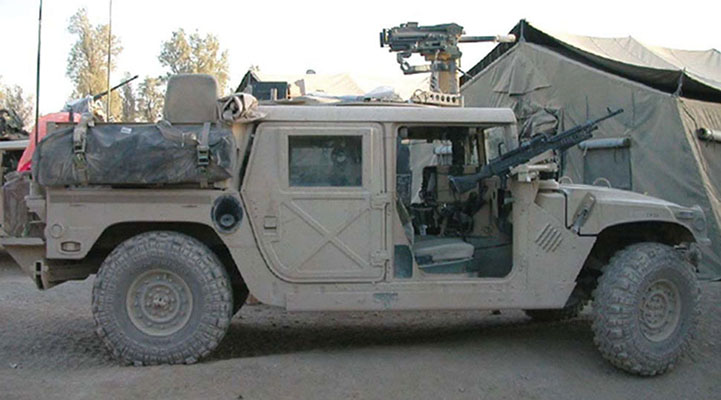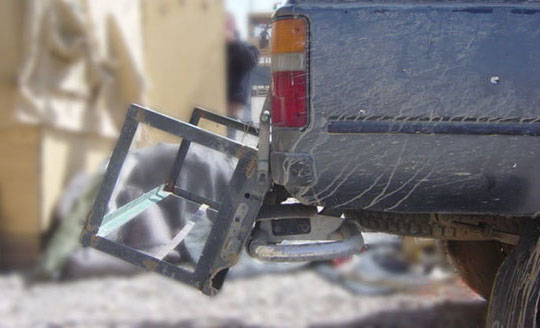The primary mission of the 7th Special Forces Group (SFG) is to provide the full spectrum of Special Forces capabilities in support of U.S. Southern Command (SOUTHCOM).1 However, with the events of 9/11 and the beginning of the Global War on Terrorism, missions and focus areas have expanded for both the Army and its special operations forces. When Operation ENDURING FREEDOM (OEF) began, the soldiers of the 7th SFG, and Operational Detachment - Alpha (ODA) 744 in particular, soon discovered that their excellent training and good planning served them just as well in the high deserts of the Middle East as in the lush terrain of Latin America.

Although Afghanistan is 8,000 miles and nine time zones distant from South America, the leadership of 2nd Battalion, 7th Special Forces Group (2/7th SFG) felt ready and qualified for its new mission. As the battalion conducted an in-depth mission analysis, many similarities between the insurgencies in Afghanistan and insurgencies in parts of Latin America emerged. The “people equation” was similar in both regions: poverty plus drugs plus an insurgency attempting to regain power equals an unconventional warfare environment—whether it is in El Salvador, Colombia, or Afghanistan.2
On 17 July 2002, 7th SFG received the warning order for the deployment of one battalion to replace 2nd Battalion, 3rd SFG in Afghanistan. With a transition date of 1 October 2002, mission planners quickly changed their focus from the SOUTHCOM area to Afghanistan. Units at all levels, from the battalion through the companies to the individual ODAs, initiated a detailed mission analysis to prepare the Special Forces soldiers for the impending deployment.3
The next two months became a whirlwind of preparation for the soldiers. Two primary activities consumed the most time: the integration of new personnel and training. All ODAs received new personnel, some fresh from the Special Forces Qualification Course, while other personnel transferred from within the group or battalion. Some ODAs gained as many as five or six soldiers to bring them up to their full strength of twelve soldiers. All soldiers trained with a variety of vehicles and weapons, including emergency close air support, preparing for the Afghan environment.
The 2/7th SFG’s operational area was in the southern Pashtun-speaking areas of Afghanistan, with the command and control based out of the Forward Operational Base (FOB) 72 located at Kandahar Airfield.4 Based on its assessment of this operational area, the Advanced Operations Base (AOB) 740 staff determined a new U.S. firebase was required to combat Taliban insurgents in Helmand Province, located about 120 kilometers west of Kandahar.5
The southern portion of Afghanistan was virtually absent of coalition personnel, except for one or two ODAs from 20th SFG that ran sporadic missions to the west, east and south of Kandahar. The AOB 740 assessment showed two potential areas west and south of Kandahar Province to place ODAs. Upon arrival of its main body, AOB 740 ordered ODAs 744 and 741 to establish the new firebase camp at Gereshk in Helmand Province. While Lashkar Gah was the provincial capital, Gereshk was located near both Highway 1—the primary east-west line of communication (LOC) through the province and the entire southwest part of Afghanistan (Iran to Kandahar to the Pakistani border through Spin Boldak)—and along the primary north-south LOC for entry into the central region.

In the last week of October 2002, ODAs 744 and 741 led a convoy of twenty-nine vehicles to the Gereshk firebase site. Heavy construction support for the firebase came from the engineers of the 769th Engineer Battalion (Louisiana National Guard) assigned to Task Force 180. After about three weeks, with the firebase construction completed, the engineers departed. Ultimately, the inner perimeter of the firebase was approximately one-mile in circumference.
With the establishment of Firebase Gereshk, additional forces were attached to continue the unconventional warfare campaign against the Taliban and al-Qaeda forces in the province. Firebase Gereshk grew from housing the two 2/7th SFG ODAs to supporting a civil affairs (CA) team and a tactical psychological operations (PSYOP) team. Colocated at the firebase via the Coalition Joint Civil Military Operations Task Force (CJCMOTF), was a civil affairs team from the 403rd Civil Affairs Battalion.6 The three-man Tactical PSYOP Team (TPT 24) from the 345th PSYOP Company was attached via FOB 72.7 The SF, CA, and PSYOP elements worked together to plan and conduct missions throughout Helmand Province in a balancing act that placed force protection at the highest level. The ODAs conducted a variety of missions from strategic reconnaissance to direct action.
Even as their six-month tour of duty neared conclusion, the soldiers of Firebase Gereshk continued conducting missions. A two-day armed reconnaissance patrol to the Sangin district to show U.S. presence and gather intelligence exemplified a typical mission. In Sangin itself, the Detachment Commander, Captain (CPT) Steve Malloy (pseudonym), made contact with the district chief and the police chief, who expressed interest in getting support for Humanitarian Assistance (HA) projects—most notably repairs to a clinic and a school located in the district.

While CPT Malloy made no promises to the community leaders of Sangin, upon return from the patrol, he coordinated with the CA team leader, Major (MAJ) Jim Bates (pseudonym), to return to Sangin the next day to conduct a civil military operations assessment of the district, establish points of contact, and possibly prepare HA project nominations. All information collected would then be forwarded to the CJCMOTF in Kabul for approval and funding. This was a unique opportunity for the CA team, since threat levels had prevented any assessment in the Sangin district up to this point.8
A five-vehicle convoy traveled to Sangin the next day (29 March 2003). The convoy consisted of CPT Malloy and ODA 744, the entire CA team (four soldiers), one PSYOP soldier, and an interpreter. The journey to Sangin, while bumpy, was uneventful.
Upon arrival in Sangin, the CA team met with Hajji Ghul Mohammad, the district chief; Mohammad Wali Khan, the police chief; and the village elders. In the preliminary meeting, the village elders expressed two primary concerns in the district: the condition of schools and a local health clinic. The elders were concerned that other districts had received attention and humanitarian projects, while Sangin had not. In the middle of the meeting, Mohammad Wali Khan excused himself as he received a cell phone call, returning after about fifteen minutes. At the conclusion of the meeting, the group went on an assessment of the nearby school, led by Sergeant (SGT) Bill Nevens (pseudonym) of the CA team.
Midway through the school assessment, CPT Malloy received an urgent radio call from the AOB 740 Commander ordering an immediate return to the firebase in order to prepare to support of an immediate combat engagement in the vicinity of Kandahar. Unbeknownst to CPT Malloy, an operation in another part of Helmand Province had troops in contact. The soldiers hastily concluded the school assessment, apologizing to the community leaders and promising to return to Sangin as soon as possible to complete the mission. The Sangin district chief, Hajji Ghul Mohammad, insisted on escorting the convoy. However, at the edge of town he stopped and made a cell phone call. After what seemed to be a prolonged period of time, he finally said farewell, but before leaving, exchanged cell phone numbers with the CA team leader, MAJ Bates.
The small force began to wind its way back to the protection of its firebase. After only twenty minutes of driving, several soldiers noticed an Afghani male dressed in green crossing the road from west to east. He did not appear to be in any hurry or overly concerned with the convoy, which was odd, since vehicles usually elicited at least curiosity. Almost instinctively, the soldiers looked in the direction from which the lone Afghani had come and noticed several heads “popping up” on a berm about 150 meters on the right side of the convoy.
Almost instantly, rocket propelled grenades (RPGs) streaked toward the convoy, firing at the lead and trail vehicles. AK-47 and light machine gun fire immediately added to the cacophony of the ambush. An RPG missed the lead vehicle, impacting between the second and third vehicles driven by the CA team, blowing the tailgate from the second vehicle, driven by SGT Thad Santon (pseudonym). The RPG fired at the trail vehicle missed, impacting on a berm next to the road. Meanwhile, the vehicle was hammered with bullets wounding all three of the occupants: Sergeant First Class (SFC) Tim Daniels (pseudonym), Staff Sergeant (SSGT) Jacob Frazier (the Air Force close air controller), and Staff Sergeant (SSG) Orlando Morales. All of the vehicles sustained multiple hits; one of the Hilux trucks had its gearshift shot away, and another truck had over forty separate bullet holes.
Training, experience, and adrenaline kicked in and, per team procedure, the vehicle drivers raced out of the kill zone. Individual soldiers returned fire at the berm with their personal weapons as they sped out of the kill zone. Moving forward about five hundred meters, the convoy stopped, quickly set up an initial security position, and returned fire at the ambush line. As his soldiers returned fire, CPT Malloy attempted to call in a hasty contact report and get immediate close air support from FOB 72. CPT Malloy and the ODA Assistant Commander, Warrant Officer 1 (WO1) Jude Randall (pseudonym), simultaneously realized that the trail vehicle was missing. Within a few minutes of the initial ambush, WO1 Randall and three other SF soldiers reentered the kill zone to assist their comrades.





